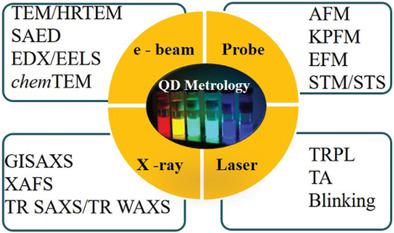当前位置:
X-MOL 学术
›
Part. Part. Syst. Charact.
›
论文详情
Our official English website, www.x-mol.net, welcomes your feedback! (Note: you will need to create a separate account there.)
Quantum Dots Microstructural Metrology: From Time‐Resolved Spectroscopy to Spatially Resolved Electron Microscopy
Particle & Particle Systems Characterization ( IF 2.7 ) Pub Date : 2020-09-21 , DOI: 10.1002/ppsc.202000192 Hasna Kudilatt 1, 2 , Bo Hou 3 , Mark E. Welland 1, 2
Particle & Particle Systems Characterization ( IF 2.7 ) Pub Date : 2020-09-21 , DOI: 10.1002/ppsc.202000192 Hasna Kudilatt 1, 2 , Bo Hou 3 , Mark E. Welland 1, 2
Affiliation

|
Colloidal quantum dots (QDs) have unique optical and electrical properties with promising applications in next‐generation semiconductor technologies, including displays, lighting, solar cells, photodetectors, and image sensors. Advanced analytical tools to probe the optical, morphological, structural, compositional, and electrical properties of QDs and their ensemble solid films are of paramount importance for the understanding of their device performance. In this review, comprehensive studies on the state‐of‐the‐art metrology approaches used in QD research are introduced, with particular focus on time‐resolved (TR) and spatially resolved (SR) spectroscopy and microscopy. Through discussing these analysis techniques in different QD system, such as various compositions, sizes, and shell structures, the critical roles of these TR‐spectroscopic and SR‐microscopic techniques are highlighted, which provide the structural, morphological, compositional, optical, and electrical information to precisely design QDs and QD solid films. The employment of TR and SR analysis in integrated QD device systems is also discussed, which can offer detailed microstructural information for achieving high performance in specific applications. In the end, the current limitations of these analytical tools are discussed, and the future development of the possibility of interdisciplinary research in both QD fundamental and applied fields is prospected.
中文翻译:

量子点微结构计量学:从时间分辨光谱到空间分辨电子显微镜
胶体量子点 (QD) 具有独特的光学和电学特性,在下一代半导体技术中具有广阔的应用前景,包括显示器、照明、太阳能电池、光电探测器和图像传感器。用于探测 QD 及其整体固体薄膜的光学、形态、结构、成分和电学特性的高级分析工具对于了解其器件性能至关重要。在这篇综述中,介绍了对 QD 研究中使用的最先进计量方法的综合研究,特别关注时间分辨 (TR) 和空间分辨 (SR) 光谱和显微镜。通过讨论不同 QD 系统中的这些分析技术,例如各种成分、尺寸和壳结构,强调了这些 TR 光谱和 SR 显微技术的关键作用,它们为精确设计 QD 和 QD 固体薄膜提供了结构、形态、成分、光学和电学信息。还讨论了 TR 和 SR 分析在集成 QD 设备系统中的应用,它们可以提供详细的微观结构信息,以在特定应用中实现高性能。最后,讨论了这些分析工具目前的局限性,并对未来在量子点基础和应用领域进行跨学科研究的可能性进行了展望。还讨论了 TR 和 SR 分析在集成 QD 设备系统中的应用,它们可以提供详细的微观结构信息,以在特定应用中实现高性能。最后,讨论了这些分析工具目前的局限性,并对未来在量子点基础和应用领域进行跨学科研究的可能性进行了展望。还讨论了 TR 和 SR 分析在集成 QD 设备系统中的应用,它们可以提供详细的微观结构信息,以在特定应用中实现高性能。最后,讨论了这些分析工具目前的局限性,并对未来在量子点基础和应用领域进行跨学科研究的可能性进行了展望。
更新日期:2020-09-21
中文翻译:

量子点微结构计量学:从时间分辨光谱到空间分辨电子显微镜
胶体量子点 (QD) 具有独特的光学和电学特性,在下一代半导体技术中具有广阔的应用前景,包括显示器、照明、太阳能电池、光电探测器和图像传感器。用于探测 QD 及其整体固体薄膜的光学、形态、结构、成分和电学特性的高级分析工具对于了解其器件性能至关重要。在这篇综述中,介绍了对 QD 研究中使用的最先进计量方法的综合研究,特别关注时间分辨 (TR) 和空间分辨 (SR) 光谱和显微镜。通过讨论不同 QD 系统中的这些分析技术,例如各种成分、尺寸和壳结构,强调了这些 TR 光谱和 SR 显微技术的关键作用,它们为精确设计 QD 和 QD 固体薄膜提供了结构、形态、成分、光学和电学信息。还讨论了 TR 和 SR 分析在集成 QD 设备系统中的应用,它们可以提供详细的微观结构信息,以在特定应用中实现高性能。最后,讨论了这些分析工具目前的局限性,并对未来在量子点基础和应用领域进行跨学科研究的可能性进行了展望。还讨论了 TR 和 SR 分析在集成 QD 设备系统中的应用,它们可以提供详细的微观结构信息,以在特定应用中实现高性能。最后,讨论了这些分析工具目前的局限性,并对未来在量子点基础和应用领域进行跨学科研究的可能性进行了展望。还讨论了 TR 和 SR 分析在集成 QD 设备系统中的应用,它们可以提供详细的微观结构信息,以在特定应用中实现高性能。最后,讨论了这些分析工具目前的局限性,并对未来在量子点基础和应用领域进行跨学科研究的可能性进行了展望。


























 京公网安备 11010802027423号
京公网安备 11010802027423号